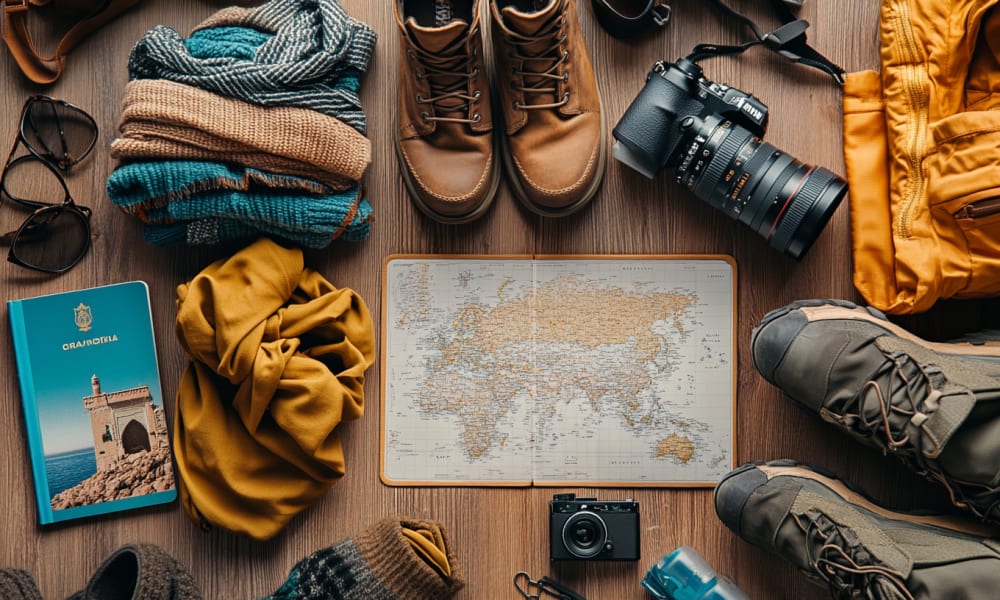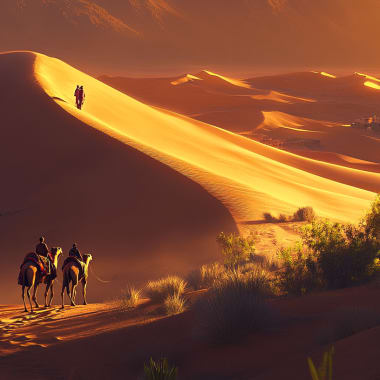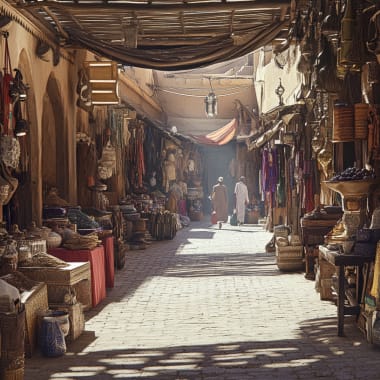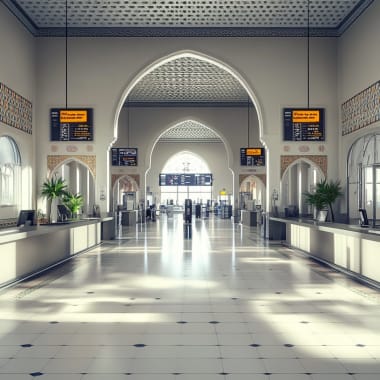
Packing list for Morocco
Why a well-planned packing list is important
Why a well-planned packing list is important
Whether it’s lively souks in Marrakech, cool nights in the Atlas Mountains, or the endless expanses of the Sahara – Morocco is a fascinating travel destination with many faces. However, this diversity also brings its own challenges. Those who travel without careful preparation risk more than just minor inconveniences: from inappropriate clothing in religious sites to painful freezing in the desert to health problems due to lack of sun protection or an incomplete travel pharmacy.
A smart packing list is therefore the key to a safe, comfortable, and respectful journey. It helps you meet cultural customs, master climatic extremes, and be prepared for spontaneous outdoor adventures. In this article, we show you what really matters in preparing for a trip to Morocco – so you can embark on this impressive country in style, with ease, and well-equipped.
Clothing for Morocco: Stylish and appropriate
Anyone traveling to Morocco wants to be not only well-prepared but also stylish and respectful. The country impresses with a unique blend of traditional values, modern influences, and a variety of climate zones – from hot desert sand to cool mountainous regions. This diversity makes the right clothing choice a crucial part of your travel preparation.
Clothing for different climate zones
Morocco is a land of contrasts – and this is also reflected in its climate. In the cities, it is often hot, surprisingly cool in the mountains, and in the desert, temperatures can vary by more than 30 degrees between day and night. Those who pack correctly here rely on the tried-and-tested layered look: several lightweight layers that can be combined depending on the weather.
For city strolls and souks, airy tunics, loose dresses, or long trousers made of natural materials such as cotton or linen are suitable. Functional clothing is recommended for the desert – such as trekking pants, functional shirts, and a light jacket for cool evenings. In the mountains, fleece, sweaters, and long socks provide cozy warmth. And even though it’s tempting: swimwear belongs exclusively at the hotel pool or on the beach.
Accessories like a sun hat, sunglasses, a light scarf, and comfortable shoes (sneakers, hiking shoes, or sandals) not only make the outfit practical but also stylish.
Respectful clothing culture in Morocco
Morocco is an Islamic country with a high value placed on decency and a well-groomed appearance. Although there are no official dress codes for tourists, appropriate clothing is highly appreciated – and contributes to a more relaxed travel experience.
Basic rule: Shoulders and knees should be covered – for both men and women. Especially in rural areas, when visiting mosques, or in traditional neighborhoods, this is a sign of respect. Women should opt for loose dresses, skirts, or pants in combination with a blouse or tunic. A scarf in the luggage is ideal for spontaneously covering shoulders or hair. Men should avoid tank tops and wear at least knee-length pants.
Context is also important: What is perfectly fine at the hotel pool or in a riad may appear inappropriate in a village or at a celebration. Those who adapt will not only be perceived positively but often also gain a more authentic access to the culture of the country.
Essential travel documents and their storage
To ensure your trip to Morocco goes smoothly, all important documents should be complete, readily available, and securely stored. Especially in a country with strict entry requirements, varying climate zones, and sometimes remote areas, good document organization is essential. Missing documentation or the loss of important papers can not only be stressful but also expensive in serious cases.
What must not be missing: your passport must be valid for at least six months upon entry – an ID card is not enough. Flight tickets, hotel bookings, proof of international health insurance, and – depending on the situation – an international driver’s license or a consent form for minor travelers should also be in your luggage. A vaccination card with current standard vaccinations is also recommended, especially for longer stays or chronic pre-existing conditions. For tourist stays of up to 90 days, nationals from Germany, Austria, and Switzerland do not need a visa. Important: Emergency contacts and a credit card should also not be forgotten – preferably supplemented by small amounts of cash in dirhams.
To keep your documents safe: Carry essential documents like your passport, credit card, and flight ticket directly on your body when arriving – for example, in a money belt or chest pouch. Upon arrival, a hotel safe offers a secure storage option while you carry only copies in everyday life. These should be kept both in paper form (distributed across multiple pieces of luggage) and digitally. For this, use an encrypted cloud, your email inbox, or secure storage on your smartphone. Travel cases or document folders help keep track – as does a list of important emergency contacts on waterproof paper.
With a smart combination of originals, copies, and digital backups, you are well-prepared – whether at check-in, at the airport, or on spontaneous outings to more remote regions.
The right choice of luggage
Choosing the right luggage for Morocco is more than just a matter of personal taste – it can determine comfort and stress levels during your trip. Depending on whether you are strolling through narrow alleys in the old town, undertaking a trekking tour in the Atlas Mountains, or riding a camel through the Sahara, each region has its own requirements.
A classic suitcase is particularly suitable for trips with fixed accommodations in cities like Marrakech, Fès, or Casablanca. It offers stability, protection, and visibility – ideal if you primarily stay in hotels and do little walking. However, it quickly reaches its limits on unpaved paths, in riads with many stairs, or during spontaneous changes of locale.
A backpack, on the other hand, is the best choice for round trips, adventures in nature, or using public transport. It is comfortable to carry, holds up on uneven paths, and offers maximum flexibility – whether hiking in the Atlas Mountains or taking a bus to remote oases. However, additional padding is required for sensitive luggage like technology or glass bottles.
A travel bag with a shoulder strap or wheels can be a good compromise – lighter than a suitcase, roomier than a pure backpack. Especially for combined travel formats – such as city sightseeing followed by a desert tour – it proves to be flexible, though less comfortable for longer distances on foot.
Tip: Be sure to add a smaller, lightweight daypack to your main luggage. This is essential for outings, souk visits, or day tours – and ensures that you have water, snacks, sunscreen, and your camera readily available.
Special gear for desert adventures
A desert trip in Morocco means starry nights, endless dunes, and a touch of adventure. However, the Sahara is not a place for spontaneity when it comes to equipment. Those who set off unprepared risk not only discomfort but also serious health risks. A well-thought-out packing list is therefore essential to confidently face heat, cold, sand, and sun.
Safety, orientation, and comfort – must be included
For nighttime outings or orientation in the camp, a headlamp, map or GPS, and a reliable power bank are essential. High-quality sunglasses, a headscarf or buff, and a sturdy water bottle with a filter protect against sun, dust, and dehydration during the day. A sturdy daypack, wind and weatherproof clothing, and warm layers for the night are also important – as temperatures can drop significantly in the desert.
Protection from sun, sand, and extreme conditions
Special UV protection clothing, sunscreen with SPF 50+, high-category sunglasses, and a head covering with neck protection are mandatory. Multi-functional scarves and sandproof bags for cameras and smartphones help against swirling sand. In the cool night hours, fleece jackets, hats, and gloves provide cozy warmth.
Whether a day trip or a multi-day tour with an overnight stay in a camp – those who travel with the right equipment can fully concentrate on the experience: feeling the vastness, admiring the starry sky, and enjoying Morocco's desert landscape to the fullest.
The right shoe choice for versatile activities
In Morocco, the paths lead not only through winding old towns but also over dusty desert tracks and rocky mountain slopes. Therefore, a well-thought-out pair of shoes that suits the planned activities is essential – ideally covering several uses. Because unsuitable or uncomfortable shoes can quickly turn a trip into a torment.
For city tours in Marrakech, Fès, or Rabat, comfortable sneakers or lightweight shoes with a firm, non-slip sole are suitable. They provide protection against dust, dirt, and uneven pavement – and also withstand an extensive stroll through the souks. Those planning hikes in the Atlas Mountains should opt for sturdy, ankle-high hiking shoes with good tread. Weather-resistant materials like Gore-Tex also offer extra protection in changing conditions. For desert tours, lightweight, breathable trekking shoes or desert boots are ideal – keeping sand out and feet comfortably cool.
Multi-functional travel shoes offer a comfortable solution for those who want to stay flexible. Models like the Lowa Delago GTX Lo or the Tecnica Sulfur GTX have proven themselves as true all-rounders in tests – comfortable, lightweight, and stable enough for both city and nature. For those who prefer something more demanding, there are ankle-high variants like the Scarpa Rush TRK GTX or the Salewa MTN Trainer 2 Mid GTX, which also impress with comfort and support on longer trekking tours.
Our tip: Make sure to break in new shoes before your trip – this way you avoid painful blisters. And remember to pack a pair of lightweight sandals or flip-flops for the accommodation or a visit to the hammam. With the right selection of shoes, you are well-equipped for the many facets of Morocco – whether on foot through medinas, over dunes, or up in the mountains.
Preparation for climatic challenges
Morocco is a land of contrasts – and this is especially true for its climate. The range of weather conditions extends from the windy coasts of the Atlantic to the hot interior of the country and up to snow-capped peaks in the Atlas Mountains and the extreme heat of the desert. Those who travel well-prepared can fully enjoy this variety without breaking a sweat – or freezing.
Flexibility is everything: Clothing for every climate
Since temperatures can vary greatly not only between regions but also within a single day, a clever layered look is recommended. Lightweight, breathable clothing made of cotton or linen provides pleasant cooling in hot regions, while a warm sweater or jacket is indispensable in the mountains or at night in the desert. Especially practical are a lightweight scarf for sun protection or shoulder wrap as well as a rain jacket for unexpected weather changes – particularly in winter or in the highlands.
Well-protected on the go: Facing sun, wind, and cold
Sun protection is a must in Morocco. Sunscreen with a high SPF, good sunglasses, and a head covering are just as important as sufficient water and avoiding direct sunlight during midday. For evening hours – especially on the coast or in greener regions – mosquito repellent should also not be missing. Practical and stylish at the same time: Argan oil from Morocco, which protects and nourishes skin and hair from drying out.
Those who adapt to the climate pack not only functionally but also responsibly – and enjoy Morocco in all its diversity without weather stress.
Useful accessories for stylish travel
In Morocco, centuries-old traditions meet modern travel worlds – a perfect opportunity to equip yourself stylishly, practically, and well-prepared. The right accessories not only provide comfort but also ensure that you remain confident and well-organized in every situation – whether at the souk in Marrakech, on a desert trip, or while walking through Fès.
Multi-functional scarves and stylish shawls are part of the basic equipment. They protect against sun, wind, and dust, can be used as head coverings, shoulder wraps, or light blankets – and are simultaneously a fashionable statement. Particularly practical: Models with integrated UV protection or locally purchased scarves with intricate embroidery, which also make a lovely souvenir.
Space-saving helpers like packing cubes with compression function, a lightweight travel towel made of microfiber, or a foldable daypack significantly ease being on the go. Those who value technology and security opt for crossbody bags with RFID protection, a smart wallet with tracker, or an electronics organizer for cables and chargers. This way, everything remains handy and well-protected.
Comfort is ensured by accessories like a travel pillow with memory foam, earplugs, and sleep mask, as well as a reusable water bottle with filter – essential for long journeys, nights in riad hotels, or hikes in remote regions. And anyone wanting to keep an eye on their luggage should not forget a digital luggage scale and a combination lock.
With thoughtful, multi-functional accessories, you can travel not only stylishly but also relaxed and well-prepared throughout Morocco – from the first day of travel to your return.
Discover the Orient with experts who have explored every corner themselves
Your dream holiday, tailor-made by experts.
We don't just know the Middle East from books, we visit the country several times a year to experience the culture, landscape and people first-hand.
From your first enquiry to your return home, we are there for you personally - by phone, email or WhatsApp, whenever you need us. Our trips are as unique as you are: individually planned and provided with exclusive privileges and high-quality arrangements that will make your trip unforgettable.
Experts for your Orient trip







